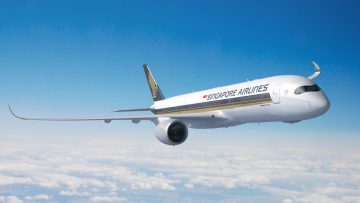
Ever since the Airbus A340-500 appeared on the scene there have been developments in ultra long-haul (ULH) flying.
But ULH flights come at a cost as I have noted many times both here and in the magazine.
The cost comes in the form of higher fuel consumption. A former boss of Air France branded the A340-500 a “flying fuel tanker”.
This is because when operating a ULH flight the aircraft must burn fuel in the early stages just to carry fuel.
Although matters have improved over the years, with Airbus having developed an ULH version of its A350, these twin engine aircraft still have higher fuel burn.
As you will now be aware Qantas intends to operate these long-haul A350-1000s non-stop between Sydney and London and return.
Qantas CEO: Project Sunrise is “final fix for the tyranny of distance”
Cirium, an analytics and data firm for aviation, publishes “Ascend by Cirium”, and in its current issue Richard Evans reports that “The aviation industry has always sought to reduce fuel burn and weight in order to reduce operating costs, but ULH flights do burn a lot [of fuel] hence have higher CO2 emissions”.
For example Qantas’ A350-1000s used for Sydney-London are set to accommodate just 238 passengers, as against a normal configuration of some 330.
Cirium’s Global Aircraft Emissions Monitor calculates that for a London-Sydney flight the A350-1000 is estimated to use 125 tonnes of fuel.
If this flight were to stop half-way the fuel consumption for both legs would be 10 per cent less. This is because on a nonstop it carries the weight of the fuel required for the second half of the flight.
The C02 emissions per passenger for the nonstop flight, compared to a one-stop routing, would be up to 50 per cent higher as a result of both the fuel and the lower number of passengers on the aircraft. Nevertheless, Qantas has previously claimed that its ULH flights will be carbon neutral from day one.
There are of course other considerations to be made when analysing ULH flights – as former airline executive Mike Carrivick notes, “It would be interesting to undertake a full analysis of all costs and emissions between nonstop flights and those with a half-way stop”.
“Fuel, and its overall impacts is obviously a factor, but there must be considerable savings in other areas, plus efficiencies by not stopping en route.”
Andy Foster, a senior lecturer in transport management at Cranfield University, agrees and adds “not to mention additional maintenance costs for the extra landing and take-off”.
In the past both British Airways and Qantas operated one-stop flights to Sydney and Melbourne via Bangkok. The Thai capital is roughly half-way along the route. Today both operate via Singapore (not exactly half-way).
So all in all it’s a complex issue and one which will be endlessly debated over the coming months and years.
And that’s assuming fuel prices remain stable. When they were last hiked to unsustainable levels ULH flights fell out of favour.












